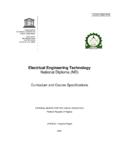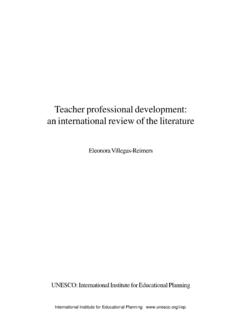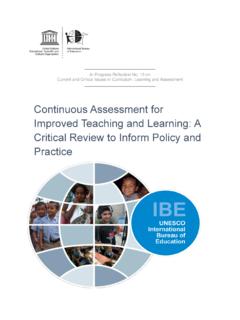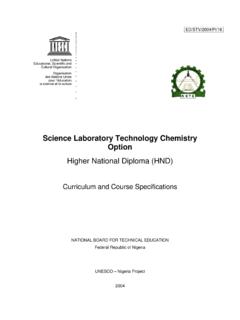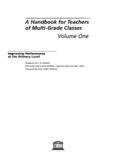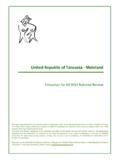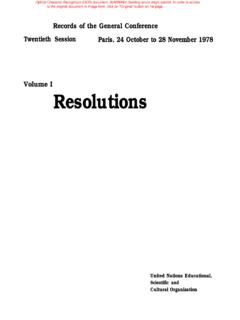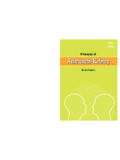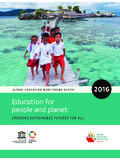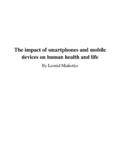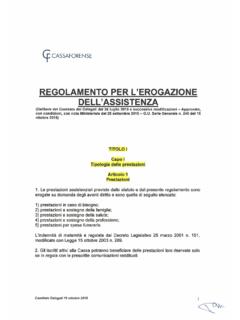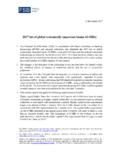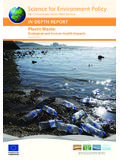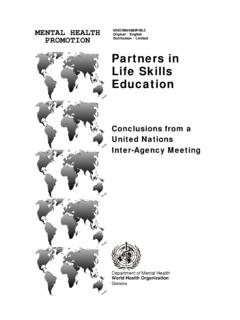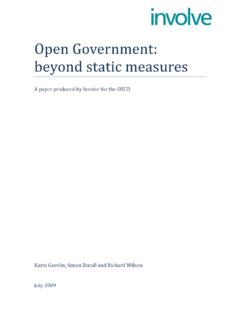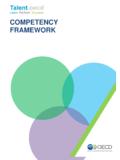Transcription of ICT competency standards for teachers: …
1 For further information please visit: competency standards FOR TEACHERSC ompetency standards ModulesICT competency standards FOR TEACHERSICT competency standards FOR TEACHERSP ublished in 2008by the United Nations Educational, Scientific and Cultural Organization7, place de Fontenoy, 75352 PARIS 07 SPComposed and printed in the workshops of METIA UNESCO 2008 These materials may be reproduced, translated, distributed or displayed for non-commercial purposes, provided that you give attribution to in the United KingdomCI-2007/WS/19 competency standards MODULESF orewordTo live, learn, and work successfully in an increasingly complex, information-rich and knowledge-based society, students and teachers must utilize technology effectively. Within a sound educational setting, technology can enable students to become: Capable information technology users Information seekers, analyzers, and evaluators Problem solvers and decision makers Creative and effective users of productivity tools Communicators, collaborators, publishers, and producers Informed, responsible, and contributing citizens Through the ongoing and effective use of technology in the schooling process, students have the opportunity to acquire important technology capabilities.
2 The key individual in helping students develop those capabilities is the classroom teacher . The teacher is responsible for establishing the classroom environment and preparing the learning opportunities that facilitate students use of technology to learn, and communicate. Consequently, it is critical that all classroom teachers are prepared to provide their students with these opportunities. Both professional development programs for teachers currently in the classroom and programs for preparing future teachers should provide technology-rich experiences throughout all aspects of the training. standards and resources within UNESCO s project ICT competency standards for Teachers (ICT-CST) provide guidelines for all teachers, specifically for planning teacher education programs and training offerings that will prepare them to play an essential role in producing technology-capable students.
3 Today s classroom teachers need to be prepared to provide technology-supported learning opportunities for their students. Being prepared to use technology and knowing how that technology can support student learning have become integral skills in every teacher s professional repertoire. Teachers need to be prepared to empower students with the advantages technology can bring. Schools and classrooms, both real and virtual, must have teachers who are equipped with technology resources and skills and who can effectively teach the necessary subject matter content while incorporating technology concepts and skills. Interactive computer simulations, digital and open educational resources, and sophisticated data-gathering and analysis tools are only a few of the resources that enable teachers to provide previously unimaginable opportunities for conceptual understanding.
4 Traditional educational practices no longer provide prospective teachers with all the necessary skills for teaching students to survive economically in today s workplace. 1 ICT competency standards FOR TEACHERS2 Foreword cont dThrough the ICT-CST project, UNESCO is responding to: (a) its function as a standard-setting agency, (b) its mandate within the Education for All (EFA) Programme, (c) its mandate as the lead agency for action lines C4 on capacity building (with UNDP) and C7 on e-learning as decided by the Geneva Plan of Action adopted by WSIS1 (2003) and (d) to its overarching objective of building inclusive knowledge societies through communication and ICT-CST project provides a complete framework for ICT competency standards for Teachers by (a) addressing the underlying Policy Framework (document 1 of 3), (b) examining the components of educational reform and developing a matrix of skill sets for teachers which correspond to various policy approaches and education reform components2 (document 2 of 3), and (c)
5 Providing a detailed description of the specific skills to be acquired by teachers within each skill set/module3 (document 3 of 3). The second phase of the ICT-CST project involves the establishment of a UNESCO mechanism to endorse training programs for compliance with the UNESCO standards . The complete guidelines for submission, evaluation and endorsement will be published on the UNESCO website dedicated to this project: , UNESCO will map existing teacher training standards and training programs to the ICT-CST matrix of skill sets in an attempt to streamline the global efforts in this general area. We do hope that this work will contribute to the development of appropriate training programs for ICT skills of teachers with a global , it is important to note that the development of the UNESCO ICT-CST has been a true example of the power of strategic public-private partnerships for development.
6 We are pleased to acknowledge the outstanding support of our numerous partners in both academia and the IT private sector. Most notably, we would like to express our gratitude to Microsoft, Intel, Cisco, the International Society for Technology in Education (ISTE) and the Virginia Polytechnic Institute and State University (Virginia Tech). Their contributions are greatly Waheed KhanAssistant Director-General for Communication and InformationUNESCO1. WSIS stands for the World Summit on the Information Society which was held in two phases. The first phase took place in Geneva from 10 to 12 December 2003 and the second phase took place in Tunis, from 16 to 18 November 2005. Check for more Such a matrix is referred to as the competency standards Modules .3. Such description is included in the Implementation Guidelines document. It is important to note that this document is a dynamically evolving set of guidelines which will be continuously updated and posted on the website to reflect technology evolution on the teaching/learning standards MODULESAll names are listed alphabetically by first contact Mr Tarek Shawki (Project Director)
7 At for further Elah Al-AyyoubAlan BennettAlex WongAllan JolliffeAmmar AlhusainiAndrea KarpatiAstrid DufborgBarbara LockeeChirs DedeChris MorleyClaude LuttgensCristian CoxDiogo VasconcelosDoug BrownEllie MeleiseaGabriel AccascinaGordon ShukwitHala LattoufHerve MarcheHoda BarakaUNESCOA bdul Waheed Khan Armelle ArrouElizabeth Longworth Caroline PontefractCedric WachholzGeorge HaddadJean-Claude DauphinMariana Patru Miriam NisbetRen CluzelTarek Shawki Yong-Nam KimHugh JaggerJohn CouchJohnson NkuuheKhalid TouqanKilemi MwiriaMostafa NaserddinNancy LawNiki DavisOla ErstadOsama MimiOskar SandholtPascal CagniPaul NicholsonPornpun WaitayangkoonRita Ellul Ronald OwstenSoon Fook FongTheo TeederTim UnwinYosri El-GamalPartners (Cisco, Intel, ISTE, Microsoft)Alethea Lodge-ClarkeClaudia TothDon KnezekFrank McCoskerJim WynnJulie ClugageLizzie RangeLynn NolanMark EastMartina RothMichelle SelingerPaul HengeveldRobert KozmaWendy HawkinsCOMPETENCY standards MODULESThe Curriculum FrameworkBy crossing the three approaches to education reform1 based on human capacity development technology literacy, knowledge deepening, and knowledge creation with the six components of the educational system policy, curriculum, pedagogy, ICT, organization, and teacher training a curriculum framework is created for the UNESCO ICT competency standards for Teachers (ICT-CST) project.
8 Each of the cells of the matrix constitutes a module in the framework. Within each of these modules, there are specific curricular goals and teacher skills. An overview of these modules is presented below and in the attached appendices. A draft description of detailed teacher competencies, objectives, and methods for each module is provided in a companion website, specifically designed for professional development providers and teacher educators. The intent is that providers and educators will review the curriculum framework and the competency standards with an eye to developing new learning materials or revising current materials so as to support one or more of the three approaches. In parallel, providers and educators can comment on the draft competencies, enabling the community to collectively shape the standards . The first component policy and vision is used as a given in the ICT-CST framework.
9 That is, it is assumed that a country is starting with one or more of these specific approaches to education reform based on their economic and social development goals. However, once an approach has been selected each has different implications for other components of the education system and for teacher professional development programs. These implications are elaborated below5 teacher PROFESSIONAL DEVELOPMENTORGANIZATION & ADMINISTRATIONICTPEDAGOGYCURRICULUM AND ASSESSMENTPOLICY AND VISIONTECHNOLOGYLITERACYKNOWLEDGEDEEPENI NGKNOWLEDGECREATIONBASICKNOWLEDGEKNOWLED GEAPPLICATION21st CENTURYSKILLSINTERGRATETECHNOLOGYCOMPLEX PROBLEMSOLVINGSELFMANAGEMENTBASICTOOLSCO MPLEXTOOLSPERVASIVETOOLSSTANDARDCLASSROO MCOLLABORATIVEGROUPSLEARNINGORGANIZATION SDIGITALLITERACYMANAGEAND GUIDETEACHER AS MODEL LEARNERTEACHER PROFESSIONAL DEVELOPMENTORGANIZATION & ADMINISTRATIONICTPEDAGOGYCURRICULUM AND ASSESSMENTPOLICY AND VISIONTECHNOLOGYLITERACYKNOWLEDGEDEEPENI NGBASICKNOWLEDGEKNOWLEDGEAPPLICATIONINTE RGRATETECHNOLOGYCOMPLEX PROBLEMSOLVINGBASICTOOLSCOMPLEXTOOLSSTAN DARDCLASSROOMCOLLABORATIVEGROUPSDIGITALL ITERACYMANAGEAND GUIDETEACHER PROFESSIONAL DEVELOPMENTORGANIZATION & ADMINISTRATIONICTPEDAGOGYCURRICULUM AND
10 ASSESSMENTPOLICY AND VISIONTECHNOLOGYLITERACYBASICKNOWLEDGEIN TERGRATETECHNOLOGYBASICTOOLSSTANDARDCLAS SROOMDIGITALLITERACY1. This document follows a companion UNESCO document whose title is UNESCO ICT competency standards for Teachers Policy Framework . ICT competency standards FOR TEACHERST echnology LiteracyAs stated above, the policy goal of the technology literacy approach is to prepare learners, citizens, and a workforce that is capable of taking up new technologies so as to support social development and improve economic productivity. Related policy goals include increasing enrollments, making quality resources available to all, and improving literacy skills, including the use of a range of hardware and software resources and tools. Teachers should be aware of these goals and be able to identify the components of education reform programs that correspond to these policy goals.
